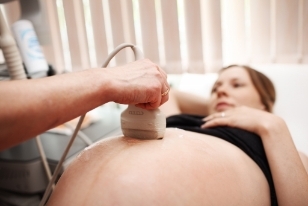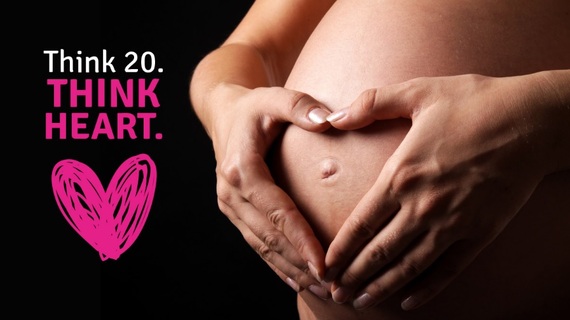By Aimee Foster
There’s so much more to the 20 week anomaly scan than we sometimes realise. I was one of those parents who left the scan room with more than a blurry picture. My baby was the reason this scan is offered to all pregnant women. She was sick, she needed help and without this scan we wouldn’t have had a clue.
It is the most detailed medical examination your baby will have during pregnancy. Each of your baby’s tiny organs will be checked in turn to ensure they are developing properly. The odds are everything will be fine and the shadowy, hazy picture on screen will reveal a healthy baby. But what happens if this isn’t the case?
(Image Credit: Tiny Tickers)
A natural worrier, during my first pregnancy I obsessed over every minute detail. The complicated and delicate process of growing a baby overwhelmed me and I fretted over every act and omission I had made. I hadn’t taken folic acid pre-conception. I had a few boozy evenings before I even knew of my little friend’s existence. I’d had too many hot baths…the list of worries was endless. The 20 week scan loomed before, a possible crescendo of all these unwelcome anxieties.
Perched on a brown plastic chair outside the scan room, I was physically shaking. In my head I’d been through all the worst case scenarios. I’d lost her over and over again.
Every time the sonographer checked off a tiny organ or body part as healthy, the iron fist clenching my stomach loosened its grip slightly. After the scan was complete (and I left with the obligatory pictures and gender knowledge), I relaxed a little although my fears didn’t completely dissolve until she arrived 20 weeks later.
And arrive she did, in a shock of black hair and disgruntled screams. Bonny and healthy, she was living proof that there had been no reason to worry.
The second time round, I was far more relaxed about the whole baby-growing process. My body had done it before, it knew the deal. On the day of the anomaly scan I felt relaxed and perfectly able to hold a paper cup of coffee without my shaking limbs spilling its contents everywhere.
Seconds before the sonographer called us in, I said to my husband, ‘I can’t believe I was so scared before Susie’s scan. This time I’m not worried at all’.
Oh the irony. The blessed irony of those words.
The scan progressed much the same as my first. The crucial difference occurred when the sonographer reached the baby’s heart. She was silent for too long. There were too many clicks of buttons and too much eye narrowing. I felt cold fear growing inside, rising up to my throat and rendering me unable to speak.
‘There’s something wrong with your baby’s heart’.
I stared at her blankly, still unable to speak or comprehend her life-changing words.
‘Your baby’s heart looks asymmetrical,’ she explained. ‘I need to get the doctor.’
After another deafeningly silent examination, the doctor said she thought she knew what was wrong with our baby’s heart but that she didn’t want to tell us the exact diagnosis until we had seen a fetal cardiologist at the John Radcliffe Hospital. She explained that this was to prevent us from jumping on Google when we got home, which incidentally was all I wanted to do. She must have known the burning desire for answers would in no way be fulfilled by Dr Google.
We left the scan room with a million unanswered questions scattered between burgeoning hopes that this was all a big mistake.
As we drove home, I turned on my phone to find numerous messages from friends and family asking about the gender of the baby. Forgetting my new burden for a second, I managed a small smile. I had almost forgotten we were having another girl. I couldn’t even begin to fathom how to answer those texts and messages. The gender of our baby, which had seemed so crucial a few hours earlier, was now so utterly insignificant.
The neat scan room at the John Radcliffe and our soft-spoken fetal cardiologist became part of our weekly routine until our baby, Grace, was delivered by Caesarean section at 32 weeks gestation.
Before her delivery, we came to know the scan process intimately. To this day, the skill with which our consultant was able to examine Grace’s tiny heart takes my breath away. To me it looked like a mass of greys and blacks, all running into each other like a monochrome watercolour painting. But with the expertise of our consultant we were able to understand Grace’s heart condition and plan and prepare for her birth.
To the sonographer who first spotted Grace’s heart defect, I will always owe my immense gratitude. The alternative scenario, had we continued in the dark without any knowledge of what was really going on inside, plays out in my head often. The sonographer’s eagle eye not only gave us 12 weeks to prepare but also instant access to the best medical care available. In circumstances such as these that’s really all you want – to know your baby is receiving the best treatment possible with no regrets about what could have been if only you’d known.
Heart defects are the most common of all birth defects, affecting one in 111 babies. Early diagnosis gives babies a better chance of survival and long term quality of life. Detection during pregnancy means the right medical experts can be on hand at birth, treatment can begin as soon as possible and parents can start getting the support they need – from the start. This is the purpose of the 20 week scan and something all parents-to-be need to be aware of.
If you are about to have your 20 week scan, the chances are everything will be fine and you will leave the scan room in a cloud of excitement and joy. But while you look forward to finding out the gender and taking home a picture to frame, please also make sure you are aware of the importance of this process and how you can help ensure you baby receives the most detailed and accurate examination possible.
If you are pregnant, you can test just how much you know about the 20 week scan through an online quiz – www.think20.org.uk – developed by Tiny Tickers, the baby hearts charity. At the end of the quiz you can also request an information pack with a checklist of questions to ask the sonographer at your 20-week scan, giving you the confidence to protect your tiny ticker.



